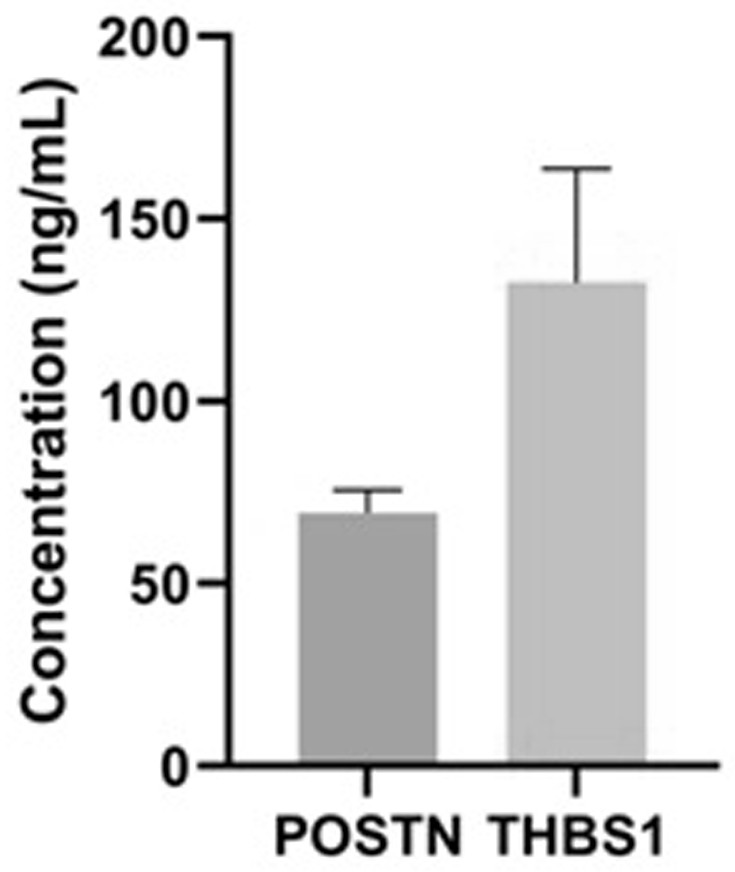Identification and application of human amniotic mesenchymal stem cell exocrine protein POSTN
An amniotic membrane mesenchymal and stromal cell technology, which can be used in medical preparations containing active ingredients, applications, peptide/protein components, etc., and can solve the problems that POSTN application research has not been in-depth and POSTN has been identified.
- Summary
- Abstract
- Description
- Claims
- Application Information
AI Technical Summary
Problems solved by technology
Method used
Image
Examples
Embodiment 1
[0023] 1. Harvest of human amniotic mesenchymal stem cell conditioned medium
[0024] Materials and Methods:
[0025] Protease inhibitor (Biyuntian)
[0026] trypsin BI
[0027] Ultrafiltration centrifuge tubes (Merck Millipore; Amicon Ultra-50, Ultracel-3k)
[0028] BCA kit (Biyuntian)
[0029] Type IV collagenase (sigma)
[0030] Osteogenic / Adipogenic / Chondrogenesis Kit (Saiye Bio)
[0031] (1) The amniotic membrane mesenchymal stem cells are obtained by the following methods:
[0032] The amniotic tissue of healthy caesarean section was taken, soaked in normal saline for 30 min, and washed repeatedly with PBS to remove mucus. Use ophthalmic surgical scissors to cut the amniotic membrane into small pieces of about 1mm × 1mm, add 10ml of 0.25% trypsin-EDTA, digest at 37°C for 30 minutes, add serum-containing culture medium, centrifuge to remove the supernatant, and repeat the digestion twice, and then use Wash 2-3 times with PBS to remove as much epithelial cells as po...
Embodiment 2
[0040] Mass spectrometry analysis of exocrine proteins from amniotic mesenchymal stem cells in conditioned medium. Protein annotation was analyzed by GeneOntology (GO). GO analysis is an important bioinformatics analysis method used to describe various characteristics of genes and gene expression products. GO annotations are divided into three categories: biological process, cellular composition and molecular function. These three classifications explain the biological functions of proteins from different perspectives. We performed statistics on the distribution of hAMSC-secreted proteins in GO secondary annotations. The results showed that exocrine proteins in hAMSCs-CM were involved in biological processes such as cell proliferation, differentiation, metabolism, immunity, and signaling pathways. The highly expressed protein POSTN was screened out. ELISA verifies the highly expressed screening proteins in amniotic mesenchymal stem cells.
[0041] Materials and Methods:
...
Embodiment 3
[0046] MTS and EDU experiments found that the protein can effectively promote the proliferation of spermatogonial stem cells.
[0047] The proliferation of cells was detected by MTS assay, according to 2.5 × 10 per well. 4 cells were seeded in 96-well plates. After 24h, different concentrations of POSTN were added to the corresponding wells. Every 24h, add 10µl MTS to the wells to be tested, then incubate at 37°C for 2h, and use a microplate reader to measure the value at a wavelength of 490nm.
[0048] In order to determine whether the two candidate proteins POSTN in hAMSCs-CM are related to cell proliferation, different concentrations (0, 10, 50, 100, 200 ng / mL) of pure POSTN protein were added to the cell proliferation medium, respectively. Cell proliferation was detected by MTS method at 0, 24, 48, 72, and 96 h. like Figure 4 As shown, the results showed that the higher the concentration of POSTN, the stronger the promoting effect on cell proliferation. From 48 hours...
PUM
 Login to View More
Login to View More Abstract
Description
Claims
Application Information
 Login to View More
Login to View More - R&D
- Intellectual Property
- Life Sciences
- Materials
- Tech Scout
- Unparalleled Data Quality
- Higher Quality Content
- 60% Fewer Hallucinations
Browse by: Latest US Patents, China's latest patents, Technical Efficacy Thesaurus, Application Domain, Technology Topic, Popular Technical Reports.
© 2025 PatSnap. All rights reserved.Legal|Privacy policy|Modern Slavery Act Transparency Statement|Sitemap|About US| Contact US: help@patsnap.com



